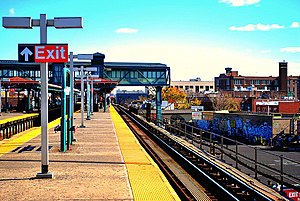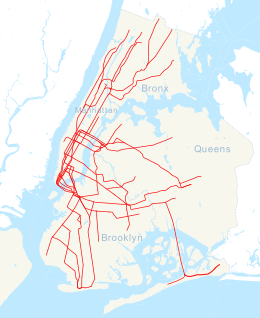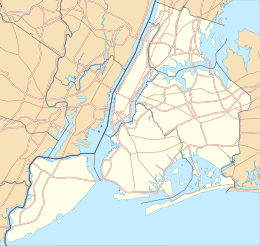railroad.wikisort.org - Station
The Junction Boulevard station (originally Junction Avenue station)[3] is an express station on the IRT Flushing Line of the New York City Subway, located at the intersection of Junction Boulevard and Roosevelt Avenue in Corona, Queens.[4] It is served by the 7 train at all times and by rush hour peak-direction <7> express service.[5]
Junction Blvd | ||||||||||||||||||||||||||||||||||||||||||||||||||||||||||||||||||||||||||||||||||||||||||||||||
|---|---|---|---|---|---|---|---|---|---|---|---|---|---|---|---|---|---|---|---|---|---|---|---|---|---|---|---|---|---|---|---|---|---|---|---|---|---|---|---|---|---|---|---|---|---|---|---|---|---|---|---|---|---|---|---|---|---|---|---|---|---|---|---|---|---|---|---|---|---|---|---|---|---|---|---|---|---|---|---|---|---|---|---|---|---|---|---|---|---|---|---|---|---|---|---|---|
 | ||||||||||||||||||||||||||||||||||||||||||||||||||||||||||||||||||||||||||||||||||||||||||||||||
| Station statistics | ||||||||||||||||||||||||||||||||||||||||||||||||||||||||||||||||||||||||||||||||||||||||||||||||
| Address | Junction Boulevard & Roosevelt Avenue Queens, NY 11368 | |||||||||||||||||||||||||||||||||||||||||||||||||||||||||||||||||||||||||||||||||||||||||||||||
| Borough | Queens | |||||||||||||||||||||||||||||||||||||||||||||||||||||||||||||||||||||||||||||||||||||||||||||||
| Locale | Corona | |||||||||||||||||||||||||||||||||||||||||||||||||||||||||||||||||||||||||||||||||||||||||||||||
| Coordinates | 40°44′57.03″N 73°52′8.75″W | |||||||||||||||||||||||||||||||||||||||||||||||||||||||||||||||||||||||||||||||||||||||||||||||
| Division | A (IRT)[1] | |||||||||||||||||||||||||||||||||||||||||||||||||||||||||||||||||||||||||||||||||||||||||||||||
| Line | IRT Flushing Line | |||||||||||||||||||||||||||||||||||||||||||||||||||||||||||||||||||||||||||||||||||||||||||||||
| Services | 7 | |||||||||||||||||||||||||||||||||||||||||||||||||||||||||||||||||||||||||||||||||||||||||||||||
| Transit | ||||||||||||||||||||||||||||||||||||||||||||||||||||||||||||||||||||||||||||||||||||||||||||||||
| Structure | Elevated | |||||||||||||||||||||||||||||||||||||||||||||||||||||||||||||||||||||||||||||||||||||||||||||||
| Platforms | 2 island platforms cross-platform interchange | |||||||||||||||||||||||||||||||||||||||||||||||||||||||||||||||||||||||||||||||||||||||||||||||
| Tracks | 3 | |||||||||||||||||||||||||||||||||||||||||||||||||||||||||||||||||||||||||||||||||||||||||||||||
| Other information | ||||||||||||||||||||||||||||||||||||||||||||||||||||||||||||||||||||||||||||||||||||||||||||||||
| Opened | April 21, 1917 | |||||||||||||||||||||||||||||||||||||||||||||||||||||||||||||||||||||||||||||||||||||||||||||||
| Accessible | ||||||||||||||||||||||||||||||||||||||||||||||||||||||||||||||||||||||||||||||||||||||||||||||||
| Opposite- direction transfer | Yes | |||||||||||||||||||||||||||||||||||||||||||||||||||||||||||||||||||||||||||||||||||||||||||||||
| Former/other names | Junction Avenue (1917-1940) | |||||||||||||||||||||||||||||||||||||||||||||||||||||||||||||||||||||||||||||||||||||||||||||||
| Traffic | ||||||||||||||||||||||||||||||||||||||||||||||||||||||||||||||||||||||||||||||||||||||||||||||||
| 2019 | 6,883,317[2] | |||||||||||||||||||||||||||||||||||||||||||||||||||||||||||||||||||||||||||||||||||||||||||||||
| Rank | 58 out of 424[2] | |||||||||||||||||||||||||||||||||||||||||||||||||||||||||||||||||||||||||||||||||||||||||||||||
| ||||||||||||||||||||||||||||||||||||||||||||||||||||||||||||||||||||||||||||||||||||||||||||||||
| ||||||||||||||||||||||||||||||||||||||||||||||||||||||||||||||||||||||||||||||||||||||||||||||||
| ||||||||||||||||||||||||||||||||||||||||||||||||||||||||||||||||||||||||||||||||||||||||||||||||
| ||||||||||||||||||||||||||||||||||||||||||||||||||||||||||||||||||||||||||||||||||||||||||||||||
| ||||||||||||||||||||||||||||||||||||||||||||||||||||||||||||||||||||||||||||||||||||||||||||||||
History
This elevated station opened on April 21, 1917, as Junction Avenue, as part of a large extension of the Flushing Line from its previous eastern terminus at Queensboro Plaza to Alburtis Avenue (now 103rd Street–Corona Plaza). It was part of the Brooklyn–Manhattan Transit Corporation, albeit served by shuttles of IRT dimensions, and the two companies jointly operated the Flushing and Astoria Lines due to the provisions of the Dual Contracts. The station was renamed Junction Boulevard in 1940.[6]
The city government took over the IRT's operations on June 12, 1940.[7][8] The IRT routes were given numbered designations in 1948 with the introduction of "R-type" rolling stock, which contained rollsigns with numbered designations for each service.[9] The route from Times Square to Flushing became known as the 7.[10] On October 17, 1949, the joint BMT/IRT operation of the Flushing Line ended, and the line became the responsibility of the IRT.[11] After the end of BMT/IRT dual service, the New York City Board of Transportation announced that the Flushing Line platforms would be lengthened to 11 IRT car lengths; the platforms were only able to fit nine 51-foot-long IRT cars beforehand.[12][13] The platforms at the station were extended in 1955–1956 to accommodate 11-car trains.[14] However, nine-car trains continued to run on the 7 route until 1962, when they were extended to ten cars.[15] With the opening of the 1964 New York World's Fair, trains were lengthened to eleven cars.[16][17]
In 1981, the Metropolitan Transportation Authority listed the station among the 69 most deteriorated stations in the subway system.[18]
Station layout
| 3F | Crossover | Transfer between platforms |
| 2F Platform level |
Southbound local | ← |
| Island platform | ||
| Peak-direction express | ← | |
| Island platform | ||
| Northbound local | | |
| 1F | Mezzanine | Fare control, station agent, MetroCard machines |
| G | Street level | Entrances/exits |

This station has two island platforms and three tracks.[19] The two outer local tracks are used by the full-time 7 local service while the middle express track is used by the rush-hour peak direction <7> express service.[5] Both platforms have red canopies with green frames and support columns in the center and are narrower at either ends.
Exits
This station has one elevated station house beneath the platforms tracks. Four staircases from each corner of Junction Boulevard and Roosevelt Avenue go up to a mezzanine that has a token booth in the center and a turnstile bank on the east and west sides.[20] These turnstile banks lead to a crossunder and has a single staircase going up to each platform towards the west (railroad south) end.
This station was made ADA accessible in 2007, at the cost of $6 million. From the northeast corner of the intersection this station is located at, a single elevator goes up to an enclosed overpass above the platforms with an intermediate stop at the mezzanine.[21] The overpass has two HEET turnstiles and a gate that is automatically opened when a MetroCard is swiped at either turnstile. Inside, two elevators go down to the platforms, one for each. Previously, an "AutoGate" Reduced-fare MetroCard was required to open the gate.[22][23] An emergency staircase goes down to the Manhattan-bound platform and an employee-facility is on the Flushing-bound end of the overpass.
References
- "Glossary". Second Avenue Subway Supplemental Draft Environmental Impact Statement (SDEIS) (PDF). Vol. 1. Metropolitan Transportation Authority. March 4, 2003. pp. 1–2. Archived from the original (PDF) on February 26, 2021. Retrieved January 1, 2021.
- "Facts and Figures: Annual Subway Ridership 2014–2019". Metropolitan Transportation Authority. 2020. Retrieved May 26, 2020.
- "STATION SITES FOR NEW SUBWAYS; Pamphlet Issued by Utilities Board Contains List of Stops on Dual System" (PDF). The New York Times. July 6, 1913. Retrieved September 24, 2015.
- "MTA Neighborhood Maps: Corona" (PDF). Metropolitan Transportation Authority. 2015. Retrieved September 20, 2015.
- "7 Subway Timetable, Effective September 13, 2020". Metropolitan Transportation Authority. Retrieved December 9, 2020.
- "1940 BMT system map" (PDF). NYCSubway. Retrieved June 12, 2011.
- "City Transit Unity Is Now a Reality; Title to I.R.T. Lines Passes to Municipality, Ending 19-Year Campaign". The New York Times. June 13, 1940. ISSN 0362-4331. Archived from the original on January 7, 2022. Retrieved May 14, 2022.
- "Transit Unification Completed As City Takes Over I. R. T. Lines: Systems Come Under Single Control After Efforts Begun in 1921; Mayor Is Jubilant at City Hall Ceremony Recalling 1904 Celebration". New York Herald Tribune. June 13, 1940. p. 25. ProQuest 1248134780.
- Brown, Nicole (May 17, 2019). "How did the MTA subway lines get their letter or number? NYCurious". amNewYork. Archived from the original on March 2, 2021. Retrieved January 27, 2021.
- Friedlander, Alex; Lonto, Arthur; Raudenbush, Henry (April 1960). "A Summary of Services on the IRT Division, NYCTA" (PDF). New York Division Bulletin. Electric Railroaders' Association. 3 (1): 2–3. Archived (PDF) from the original on September 14, 2020. Retrieved January 27, 2021.
- "Direct Subway Runs To Flushing, Astoria" (PDF). The New York Times. October 15, 1949. ISSN 0362-4331. Retrieved October 7, 2017.
- Bennett, Charles G. (November 20, 1949). "Transit Platforms On Lines In Queens To Be Lengthened; $3,850,000 Program Outlined for Next Year to Care for Borough's Rapid Growth New Links Are To Be Built 400 More Buses to Roll Also — Bulk of Work to Be on Corona-Flushing Route Transit Program In Queens Outlined". The New York Times. ISSN 0362-4331. Retrieved April 29, 2018.
- "37 Platforms On Subways To Be Lengthened: All Stations of B. M. T. and I.R.T.in Queens Included in $5,000,000 Program". New York Herald Tribune. November 20, 1949. p. 32. ISSN 1941-0646. ProQuest 1325174459.
- Minutes and Proceedings of the New York City Transit Authority. New York City Transit Authority. 1955. Archived from the original on September 13, 2020. Retrieved August 31, 2016.
- "R17s to the Flushing Line". New York Division Bulletin. Electric Railroaders' Association. 5 (6): M-8. December 1962 – via Issu.
- "TA to Show Fair Train". Long Island Star – Journal. August 31, 1963. Retrieved August 30, 2016 – via Fulton History.
- "A First-class Rapid Ride". Railway Age. Vol. 156, no. 21. June 1, 1964. p. 22. ProQuest 895766286.
- Gargan, Edward A. (June 11, 1981). "Agency Lists Its 69 Most Deteriorated Subway Stations". The New York Times. Retrieved August 13, 2016.
- Dougherty, Peter (2006) [2002]. Tracks of the New York City Subway 2006 (3rd ed.). Dougherty. OCLC 49777633 – via Google Books.
- "MTA Neighborhood Maps: Corona" (PDF). Metropolitan Transportation Authority. 2015. Retrieved September 20, 2015.
- s.r.o., Minion Interactive. "Junction Blvd Station - Projects | Mega Contracting Group, LLC". www.megagroup.nyc. Retrieved October 6, 2016.
- "NYC Official Accessibility Guide" (PDF). nyc.gov. City of New York. 2008. Archived from the original (PDF) on August 7, 2015. Retrieved September 20, 2015.
- Zimmer, Amy (June 13, 2002). "Stuck in the System: Disabled rider questions subway access". disablednyc.com. City Hall: Metro New York. Retrieved September 20, 2015.
External links
- nycsubway.org – IRT Flushing Line: Junction Boulevard
- Station Reporter — 7 Train
- The Subway Nut — Junction Boulevard Pictures
- Junction Boulevard entrance from Google Maps Street View
- Platforms from Google Maps Street View
На других языках
- [en] Junction Boulevard station
[ru] Джанкшен-бульвар (линия Флашинг, Ай-ар-ти)
«Джанкшен-бульвар» (англ. Junction Boulevard) — станция Нью-Йоркского метрополитена, расположенная на линии Флашинг, Ай-ар-ти. Станция находится в районе Корона, Куинс, на пересечении Джанкшен-бульвара и Рузвельт-авеню. На станции останавливаются маршруты 7 (круглосуточно) и <7> (в часы пик в пиковом направлении). Экспресс-путь используется маршрутом <7> (в часы пик в пиковом направлении). Локальные пути используются маршрутом 7 (круглосуточно).Другой контент может иметь иную лицензию. Перед использованием материалов сайта WikiSort.org внимательно изучите правила лицензирования конкретных элементов наполнения сайта.
WikiSort.org - проект по пересортировке и дополнению контента Википедии



